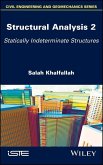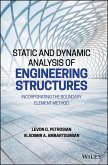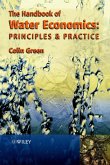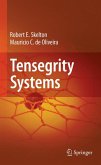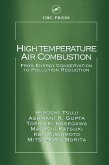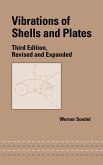Raouf A. Ibrahim
Handbook of Structural Life Assessment (eBook, PDF)
162,99 €
162,99 €
inkl. MwSt.
Sofort per Download lieferbar

0 °P sammeln
162,99 €
Als Download kaufen

162,99 €
inkl. MwSt.
Sofort per Download lieferbar

0 °P sammeln
Jetzt verschenken
Alle Infos zum eBook verschenken
162,99 €
inkl. MwSt.
Sofort per Download lieferbar
Alle Infos zum eBook verschenken

0 °P sammeln
Raouf A. Ibrahim
Handbook of Structural Life Assessment (eBook, PDF)
- Format: PDF
- Merkliste
- Auf die Merkliste
- Bewerten Bewerten
- Teilen
- Produkt teilen
- Produkterinnerung
- Produkterinnerung

Bitte loggen Sie sich zunächst in Ihr Kundenkonto ein oder registrieren Sie sich bei
bücher.de, um das eBook-Abo tolino select nutzen zu können.
Hier können Sie sich einloggen
Hier können Sie sich einloggen
Sie sind bereits eingeloggt. Klicken Sie auf 2. tolino select Abo, um fortzufahren.

Bitte loggen Sie sich zunächst in Ihr Kundenkonto ein oder registrieren Sie sich bei bücher.de, um das eBook-Abo tolino select nutzen zu können.
This important, self-contained reference deals with structural life assessment (SLA) and structural health monitoring (SHM) in a combined form. SLA periodically evaluates the state and condition of a structural system and provides recommendations for possible maintenance actions or the end of structural service life. It is a diversified field and relies on the theories of fracture mechanics, fatigue damage process, and reliability theory. For common structures, their life assessment is not only governed by the theory of fracture mechanics and fatigue damage process, but by other factors such…mehr
- Geräte: PC
- mit Kopierschutz
- eBook Hilfe
- Größe: 38.81MB
Andere Kunden interessierten sich auch für
![Structural Analysis 2 (eBook, PDF) Structural Analysis 2 (eBook, PDF)]() Salah KhalfallahStructural Analysis 2 (eBook, PDF)139,99 €
Salah KhalfallahStructural Analysis 2 (eBook, PDF)139,99 €![Static and Dynamic Analysis of Engineering Structures (eBook, PDF) Static and Dynamic Analysis of Engineering Structures (eBook, PDF)]() Levon G. PetrosianStatic and Dynamic Analysis of Engineering Structures (eBook, PDF)131,99 €
Levon G. PetrosianStatic and Dynamic Analysis of Engineering Structures (eBook, PDF)131,99 €![Handbook of Water Economics (eBook, PDF) Handbook of Water Economics (eBook, PDF)]() Colin GreenHandbook of Water Economics (eBook, PDF)195,99 €
Colin GreenHandbook of Water Economics (eBook, PDF)195,99 €![Tensegrity Systems (eBook, PDF) Tensegrity Systems (eBook, PDF)]() Robert E. SkeltonTensegrity Systems (eBook, PDF)161,95 €
Robert E. SkeltonTensegrity Systems (eBook, PDF)161,95 €![IUTAM Symposium on Topological Design Optimization of Structures, Machines and Materials (eBook, PDF) IUTAM Symposium on Topological Design Optimization of Structures, Machines and Materials (eBook, PDF)]() IUTAM Symposium on Topological Design Optimization of Structures, Machines and Materials (eBook, PDF)161,95 €
IUTAM Symposium on Topological Design Optimization of Structures, Machines and Materials (eBook, PDF)161,95 €![High Temperature Air Combustion (eBook, PDF) High Temperature Air Combustion (eBook, PDF)]() Hiroshi TsujiHigh Temperature Air Combustion (eBook, PDF)64,95 €
Hiroshi TsujiHigh Temperature Air Combustion (eBook, PDF)64,95 €![Vibrations of Shells and Plates (eBook, PDF) Vibrations of Shells and Plates (eBook, PDF)]() Werner SoedelVibrations of Shells and Plates (eBook, PDF)125,95 €
Werner SoedelVibrations of Shells and Plates (eBook, PDF)125,95 €-
-
-
This important, self-contained reference deals with structural life assessment (SLA) and structural health monitoring (SHM) in a combined form. SLA periodically evaluates the state and condition of a structural system and provides recommendations for possible maintenance actions or the end of structural service life. It is a diversified field and relies on the theories of fracture mechanics, fatigue damage process, and reliability theory. For common structures, their life assessment is not only governed by the theory of fracture mechanics and fatigue damage process, but by other factors such as corrosion, grounding, and sudden collision. On the other hand, SHM deals with the detection, prediction, and location of crack development online. Both SLA and SHM are combined in a unified and coherent treatment.
Dieser Download kann aus rechtlichen Gründen nur mit Rechnungsadresse in D ausgeliefert werden.
Produktdetails
- Produktdetails
- Verlag: John Wiley & Sons
- Erscheinungstermin: 29. März 2017
- Englisch
- ISBN-13: 9781119135494
- Artikelnr.: 52560257
- Verlag: John Wiley & Sons
- Erscheinungstermin: 29. März 2017
- Englisch
- ISBN-13: 9781119135494
- Artikelnr.: 52560257
- Herstellerkennzeichnung Die Herstellerinformationen sind derzeit nicht verfügbar.
Raouf A. Ibrahim
Department of Mechanical Engineering, Wayne State University, USA
Department of Mechanical Engineering, Wayne State University, USA
Acknowledgements xi Introduction xiii Part I Fracture Mechanics Dynamics and Peridynamics 1 1 Fundamentals of Fracture Mechanics 3 1.1 Introduction and Historical Background 3 1.2 Classical Theory of Solid Mechanics 6 1.3 Stress Intensity Factor 12 1.3.1 Analytical Development 12 1.3.2 Evaluation of Stress Intensity Factors 15 1.4 Linear Elastic Fracture Mechanics (LEFM) 17 1.4.1 Griffith's Criterion 18 1.5 Nonlinear Fracture Mechanics 19 1.5.1 Irwin's Modification 20 1.5.2 Crack Tip Element Method 22 1.5.3 Paris-ErdoganLaw 23 1.5.4 AFGROW Program 25 1.5.5 Energy Release Integrals 26 1.5.6 Mechanisms of Crack Propagation 35 1.6 Boundary
Layer Effect of Composites 38 1.6.1 Introduction 38 1.6.2 Analytical Treatment 40 1.6.3 Thermal Loading Stress Field 48 1.7 Closing Remarks 55 2 Applications of Fracture Mechanics 59 2.1 Introduction 59 2.2 Fracture Mechanics of Metallic Structures 59 2.2.1 Steel Structures 59 2.2.2 Aluminum Alloys 62 2.3 Damage of Composite Structures 70 2.3.1 Preliminaries 70 2.3.2 Assessment of Composites Mechanics 71 2.3.3 Damage of Sandwich Structures 76 2.3.4 Sandwich Plates under Normal Loads 78 2.3.5 ThermöMechanical Coupling of Sandwich Plates 90 2.3.6 Mechanics of Solid Foams 108 2.4 Closing Remarks 127 3 Dynamic Fracture and Peridynamics 129 3.1 Introduction 129 3.2 Fracture Dynamics 131 3.2.1 Features of Dynamic Fracture 131 3.2.2 Instability of Cracks and Microbranching 133 3.2.3 Experimental Techniques 139 3.2.4 Dynamic Crack Propagation Using Optical Caustics 142 3.3 Fracture Dynamics of Metals 148 3.3.1 Spalling of Metals 148 3.3.2 Dynamic Crack Propagation in Metals 149 3.3.3 Melting Metals 154 3.4 Dynamic Fracture of Composites 155 3.4.1 Functionally Graded Materials and Bi
Materials 157 3.4.2 Polymer and PMMA Materials 163 3.4.3 Fiber
Reinforced Composites 169 3.5 Peridynamics 171 3.5.1 Ingredients of Peridynamic Theory 171 3.5.2 Remarks and Restrictions 181 3.5.3 Numerical Simulation 185 3.5.4 Horizon Convergence 190 3.5.5 Application 192 3.6 Closing Remarks 208 Part II Introduction to Structural Health Monitoring 211 4 Structural Health Monitoring Basic Ingredients and Sensors 213 4.1 Introduction 213 4.2 Between Structural Life Assessment and Health Monitoring 213 4.3 Basic Ingredients of SHM 216 4.3.1 Non
Destructive Evaluation 217 4.3.2LambWaves 220 4.3.3 Acoustic Emission 227 4.3.4 Damage Location using Smart Sensors 241 4.3.5 Electric Resistance and Capacitance Techniques 251 4.3.6 Impact Resonance Method 253 4.3.7 Optimal Sensor Location 256 4.4 Closing Remarks 261 5 Statistical Pattern Recognition and Vibration
Based Techniques 263 5.1 Introduction 263 5.2 The Statistical Pattern Recognition Paradigm 264 5.2.1 Basic Concept 264 5.2.2 Damage Index and Outlier Analysis 267 5.2.3 Case Study: Impact Tests of Composite Plates 269 5.3 Vibration
Based Techniques 276 5.3.1 Overview 276 5.3.2 Damage Detection Using Strain Energy Method 278 5.3.3 Damage Detection and Location Using Modal Properties 280 5.3.4 Damage Detection Using Frequency Response Function 285 5.3.5 Damage Index and Modal Assurance Criterion 286 5.3.6 Applications 292 5.3.7 Operational Deflection Shapes/Vibration Deflection Shapes 324 5.4 Closing Remarks and Conclusions 356 Part III Reliability and Fatigue under Extreme Loading 359 6 Fatigue Life and Reliability Assessment 361 6.1 Introduction 361 6.2 Fatigue Life Assessment 362 6.2.1 Fatigue Crack Propagation 362 6.2.2 Fatigue Cumulative Damage 363 6.2.3 Half
Cycle Fatigue Life Approach 369 6.2.4 Thermal Fatigue 372 6.2.5 Acoustical Fatigue 377 6.2.6 Fatigue of Structural Joints 379 6.2.7 Design Considerations 386 6.3 Design Based on Ultimate Strength of Ship Structures 388 6.3.1 Modes of Ship Failure 394 6.3.2 Modes of Hull Failure 395 6.4 Probabilistic Models of Load Effects 398 6.4.1 Reliability Index 401 6.4.2 Limit Sate Function 403 6.4.3 Risk Analysis 408 6.4.4 Ultimate Limit State (ULS) 410 6.4.5 Reliability and Uncertainty 415 6.4.6 Reliability
Based Fatigue Assessment 418 6.4.7 Probabilistic Fracture Mechanics Assessment 421 6.5 Climate and Environmental Effects 425 6.6 Closing Remarks 428 7 Structural Reliability and Risk Assessment Under Extreme Loading 431 7.1 Introduction 431 7.2 Historic Extreme Loading Events 432 7.2.1 World Trade Center Towers (Terrorist Attack) 432 7.2.2 Ship Collisions and Grounding 436 7.2.3 Bridges under Extreme Loading 438 7.2.4 Collision of Road Tankers 443 7.3 Structural Life Assessment of Ocean Systems 444 7.3.1 Ship Structural Damage due to Slamming Loads 445 7.3.2 Damage Due to Grounding Accidents 472 7.3.3 Risk Assessment 472 7.3.4 Damage Due to Collisions 478 7.3.5 Reliability under Extreme Loading 487 7.4 Road Tanker Rollover 496 7.4.1 Rollover Scenarios and Metrics 497 7.4.2 Quasi
Dynamic Approach 506 7.4.3 Rollover of Road Tankers 508 7.4.4 International Standards of Roll Threshold 512 7.4.5 Directional Stability and Dynamics 513 7.4.6 Collision of Vehicles and Structural Fatigue 516 7.4.7 Coupled Dynamics of Liquid-Tanker Systems 520 7.4.8 Liquid-Vehicle Coupling During Braking 523 7.4.9 Passive Control of Liquid Sloshing 527 7.5 Pipes Conveying Fluids 529 7.5.1 Mechanics of the Linear Problem 530 7.5.2 Mechanics of the Nonlinear Problem 534 7.5.3 Constrained Pipes Conveying Liquid 544 7.6 Closing Remarks 557 Part IV Environment Conditions, Joints and Crack Propagation Control 561 8 Corrosion and Hydrogen Embrittlement 563 8.1 Introduction 563 8.2 Corrosion of Ocean and Aerospace Structures 564 8.2.1 Corrosion of Ocean Structures 564 8.2.2 Problems of Aluminum Ship Structures 578 8.2.3 Corrosion of Aircraft Structures 582 8.2.4 Corrosion Monitoring 588 8.2.5 Corrosion Control 589 8.2.6 Corrosion Fatigue Cracking 593 8.3 Fretting/Wear in Heat Exchangers 598 8.3.1 Analytical and Computational Models 600 8.3.2 Experimental Investigations 603 8.4 Hydrogen Embrittlement 605 8.4.1 Hydrogen Embrittlement Problems 606 8.4.2 Fatigue Crack Enhancement 608 8.4.3 Crack Growth Modeling 610 8.4.4 Hydrogen Cracking Due to Welding 611 8.5 Closing Remarks and Conclusions 613 9 Joints and Weldments 615 9.1 Introduction 615 9.2 Energy Dissipation and Nonlinearity of Joints 616 9.2.1 Friction Characteristics 616 9.2.2 Energy Dissipation 617 9.2.3 Sources of Nonlinearities 621 9.2.4 Nonlinear Identification 623 9.2.5 Force
State Mapping Technique 626 9.3 Design Considerations 629 9.3.1 Fully and Partially Restrained Joints 634 9.3.2 Sensitivity Analysis to Joint Parameter Variations 636 9.3.3 Stochastic Sensitivity 638 9.3.4 Joint Uncertainties and Relaxation 640 9.3.5 Uncertainty of Boundary Conditions and Material Properties 643 9.3.6 Mechanism of Relaxation and Loosening 645 9.3.7 Case Study A: Elastic Structures with Parameter Uncertainties and Relaxation of Joints 649 9.3.8 Case Study B:Beloiu et al. (2005) - Influence of Boundary Conditions Relaxation 662 9.4 Welded Joints 690 9.4.1 Types of Welding Processes 690 9.4.2 Aluminum Welded Panels 694 9.4.3 Fatigue Assessment of Welded Joints 696 9.4.4 Fracture Mechanics Assessment 699 9.4.5 Fatigue Improvement of Welded Joints 704 9.5 Closing Remarks and Conclusions 706 Appendix 708 10 Crack Control 711 10.1 Introduction 711 10.2 Basic Concept and Development of Crack Arresters 711 10.2.1 Basic Concept 711 10.2.2 Crack Arrest Toughness 714 10.3 Crack Arresters of Ship Structures 719 10.3.1 Crack Arresters of Metal Ship Structures 720 10.3.2 Crack Arresters of Composite Ship Structures 730 10.4 Crack Control and Repair of Aerospace Structures 737 10.4.1 Crack Control of Metallic Structures 737 10.4.2 Composite Patches 743 10.4.3 Crack Control of Composite Structures 745 10.5 Pipeline Crack Arresters 752 10.5.1 Transmission Pipelines 752 10.5.2 Buckle Arresters of Pipelines 756 10.6 Closing Remarks 763 References 767 Index 983
Layer Effect of Composites 38 1.6.1 Introduction 38 1.6.2 Analytical Treatment 40 1.6.3 Thermal Loading Stress Field 48 1.7 Closing Remarks 55 2 Applications of Fracture Mechanics 59 2.1 Introduction 59 2.2 Fracture Mechanics of Metallic Structures 59 2.2.1 Steel Structures 59 2.2.2 Aluminum Alloys 62 2.3 Damage of Composite Structures 70 2.3.1 Preliminaries 70 2.3.2 Assessment of Composites Mechanics 71 2.3.3 Damage of Sandwich Structures 76 2.3.4 Sandwich Plates under Normal Loads 78 2.3.5 ThermöMechanical Coupling of Sandwich Plates 90 2.3.6 Mechanics of Solid Foams 108 2.4 Closing Remarks 127 3 Dynamic Fracture and Peridynamics 129 3.1 Introduction 129 3.2 Fracture Dynamics 131 3.2.1 Features of Dynamic Fracture 131 3.2.2 Instability of Cracks and Microbranching 133 3.2.3 Experimental Techniques 139 3.2.4 Dynamic Crack Propagation Using Optical Caustics 142 3.3 Fracture Dynamics of Metals 148 3.3.1 Spalling of Metals 148 3.3.2 Dynamic Crack Propagation in Metals 149 3.3.3 Melting Metals 154 3.4 Dynamic Fracture of Composites 155 3.4.1 Functionally Graded Materials and Bi
Materials 157 3.4.2 Polymer and PMMA Materials 163 3.4.3 Fiber
Reinforced Composites 169 3.5 Peridynamics 171 3.5.1 Ingredients of Peridynamic Theory 171 3.5.2 Remarks and Restrictions 181 3.5.3 Numerical Simulation 185 3.5.4 Horizon Convergence 190 3.5.5 Application 192 3.6 Closing Remarks 208 Part II Introduction to Structural Health Monitoring 211 4 Structural Health Monitoring Basic Ingredients and Sensors 213 4.1 Introduction 213 4.2 Between Structural Life Assessment and Health Monitoring 213 4.3 Basic Ingredients of SHM 216 4.3.1 Non
Destructive Evaluation 217 4.3.2LambWaves 220 4.3.3 Acoustic Emission 227 4.3.4 Damage Location using Smart Sensors 241 4.3.5 Electric Resistance and Capacitance Techniques 251 4.3.6 Impact Resonance Method 253 4.3.7 Optimal Sensor Location 256 4.4 Closing Remarks 261 5 Statistical Pattern Recognition and Vibration
Based Techniques 263 5.1 Introduction 263 5.2 The Statistical Pattern Recognition Paradigm 264 5.2.1 Basic Concept 264 5.2.2 Damage Index and Outlier Analysis 267 5.2.3 Case Study: Impact Tests of Composite Plates 269 5.3 Vibration
Based Techniques 276 5.3.1 Overview 276 5.3.2 Damage Detection Using Strain Energy Method 278 5.3.3 Damage Detection and Location Using Modal Properties 280 5.3.4 Damage Detection Using Frequency Response Function 285 5.3.5 Damage Index and Modal Assurance Criterion 286 5.3.6 Applications 292 5.3.7 Operational Deflection Shapes/Vibration Deflection Shapes 324 5.4 Closing Remarks and Conclusions 356 Part III Reliability and Fatigue under Extreme Loading 359 6 Fatigue Life and Reliability Assessment 361 6.1 Introduction 361 6.2 Fatigue Life Assessment 362 6.2.1 Fatigue Crack Propagation 362 6.2.2 Fatigue Cumulative Damage 363 6.2.3 Half
Cycle Fatigue Life Approach 369 6.2.4 Thermal Fatigue 372 6.2.5 Acoustical Fatigue 377 6.2.6 Fatigue of Structural Joints 379 6.2.7 Design Considerations 386 6.3 Design Based on Ultimate Strength of Ship Structures 388 6.3.1 Modes of Ship Failure 394 6.3.2 Modes of Hull Failure 395 6.4 Probabilistic Models of Load Effects 398 6.4.1 Reliability Index 401 6.4.2 Limit Sate Function 403 6.4.3 Risk Analysis 408 6.4.4 Ultimate Limit State (ULS) 410 6.4.5 Reliability and Uncertainty 415 6.4.6 Reliability
Based Fatigue Assessment 418 6.4.7 Probabilistic Fracture Mechanics Assessment 421 6.5 Climate and Environmental Effects 425 6.6 Closing Remarks 428 7 Structural Reliability and Risk Assessment Under Extreme Loading 431 7.1 Introduction 431 7.2 Historic Extreme Loading Events 432 7.2.1 World Trade Center Towers (Terrorist Attack) 432 7.2.2 Ship Collisions and Grounding 436 7.2.3 Bridges under Extreme Loading 438 7.2.4 Collision of Road Tankers 443 7.3 Structural Life Assessment of Ocean Systems 444 7.3.1 Ship Structural Damage due to Slamming Loads 445 7.3.2 Damage Due to Grounding Accidents 472 7.3.3 Risk Assessment 472 7.3.4 Damage Due to Collisions 478 7.3.5 Reliability under Extreme Loading 487 7.4 Road Tanker Rollover 496 7.4.1 Rollover Scenarios and Metrics 497 7.4.2 Quasi
Dynamic Approach 506 7.4.3 Rollover of Road Tankers 508 7.4.4 International Standards of Roll Threshold 512 7.4.5 Directional Stability and Dynamics 513 7.4.6 Collision of Vehicles and Structural Fatigue 516 7.4.7 Coupled Dynamics of Liquid-Tanker Systems 520 7.4.8 Liquid-Vehicle Coupling During Braking 523 7.4.9 Passive Control of Liquid Sloshing 527 7.5 Pipes Conveying Fluids 529 7.5.1 Mechanics of the Linear Problem 530 7.5.2 Mechanics of the Nonlinear Problem 534 7.5.3 Constrained Pipes Conveying Liquid 544 7.6 Closing Remarks 557 Part IV Environment Conditions, Joints and Crack Propagation Control 561 8 Corrosion and Hydrogen Embrittlement 563 8.1 Introduction 563 8.2 Corrosion of Ocean and Aerospace Structures 564 8.2.1 Corrosion of Ocean Structures 564 8.2.2 Problems of Aluminum Ship Structures 578 8.2.3 Corrosion of Aircraft Structures 582 8.2.4 Corrosion Monitoring 588 8.2.5 Corrosion Control 589 8.2.6 Corrosion Fatigue Cracking 593 8.3 Fretting/Wear in Heat Exchangers 598 8.3.1 Analytical and Computational Models 600 8.3.2 Experimental Investigations 603 8.4 Hydrogen Embrittlement 605 8.4.1 Hydrogen Embrittlement Problems 606 8.4.2 Fatigue Crack Enhancement 608 8.4.3 Crack Growth Modeling 610 8.4.4 Hydrogen Cracking Due to Welding 611 8.5 Closing Remarks and Conclusions 613 9 Joints and Weldments 615 9.1 Introduction 615 9.2 Energy Dissipation and Nonlinearity of Joints 616 9.2.1 Friction Characteristics 616 9.2.2 Energy Dissipation 617 9.2.3 Sources of Nonlinearities 621 9.2.4 Nonlinear Identification 623 9.2.5 Force
State Mapping Technique 626 9.3 Design Considerations 629 9.3.1 Fully and Partially Restrained Joints 634 9.3.2 Sensitivity Analysis to Joint Parameter Variations 636 9.3.3 Stochastic Sensitivity 638 9.3.4 Joint Uncertainties and Relaxation 640 9.3.5 Uncertainty of Boundary Conditions and Material Properties 643 9.3.6 Mechanism of Relaxation and Loosening 645 9.3.7 Case Study A: Elastic Structures with Parameter Uncertainties and Relaxation of Joints 649 9.3.8 Case Study B:Beloiu et al. (2005) - Influence of Boundary Conditions Relaxation 662 9.4 Welded Joints 690 9.4.1 Types of Welding Processes 690 9.4.2 Aluminum Welded Panels 694 9.4.3 Fatigue Assessment of Welded Joints 696 9.4.4 Fracture Mechanics Assessment 699 9.4.5 Fatigue Improvement of Welded Joints 704 9.5 Closing Remarks and Conclusions 706 Appendix 708 10 Crack Control 711 10.1 Introduction 711 10.2 Basic Concept and Development of Crack Arresters 711 10.2.1 Basic Concept 711 10.2.2 Crack Arrest Toughness 714 10.3 Crack Arresters of Ship Structures 719 10.3.1 Crack Arresters of Metal Ship Structures 720 10.3.2 Crack Arresters of Composite Ship Structures 730 10.4 Crack Control and Repair of Aerospace Structures 737 10.4.1 Crack Control of Metallic Structures 737 10.4.2 Composite Patches 743 10.4.3 Crack Control of Composite Structures 745 10.5 Pipeline Crack Arresters 752 10.5.1 Transmission Pipelines 752 10.5.2 Buckle Arresters of Pipelines 756 10.6 Closing Remarks 763 References 767 Index 983
Acknowledgements xi Introduction xiii Part I Fracture Mechanics Dynamics and Peridynamics 1 1 Fundamentals of Fracture Mechanics 3 1.1 Introduction and Historical Background 3 1.2 Classical Theory of Solid Mechanics 6 1.3 Stress Intensity Factor 12 1.3.1 Analytical Development 12 1.3.2 Evaluation of Stress Intensity Factors 15 1.4 Linear Elastic Fracture Mechanics (LEFM) 17 1.4.1 Griffith's Criterion 18 1.5 Nonlinear Fracture Mechanics 19 1.5.1 Irwin's Modification 20 1.5.2 Crack Tip Element Method 22 1.5.3 Paris-ErdoganLaw 23 1.5.4 AFGROW Program 25 1.5.5 Energy Release Integrals 26 1.5.6 Mechanisms of Crack Propagation 35 1.6 Boundary
Layer Effect of Composites 38 1.6.1 Introduction 38 1.6.2 Analytical Treatment 40 1.6.3 Thermal Loading Stress Field 48 1.7 Closing Remarks 55 2 Applications of Fracture Mechanics 59 2.1 Introduction 59 2.2 Fracture Mechanics of Metallic Structures 59 2.2.1 Steel Structures 59 2.2.2 Aluminum Alloys 62 2.3 Damage of Composite Structures 70 2.3.1 Preliminaries 70 2.3.2 Assessment of Composites Mechanics 71 2.3.3 Damage of Sandwich Structures 76 2.3.4 Sandwich Plates under Normal Loads 78 2.3.5 ThermöMechanical Coupling of Sandwich Plates 90 2.3.6 Mechanics of Solid Foams 108 2.4 Closing Remarks 127 3 Dynamic Fracture and Peridynamics 129 3.1 Introduction 129 3.2 Fracture Dynamics 131 3.2.1 Features of Dynamic Fracture 131 3.2.2 Instability of Cracks and Microbranching 133 3.2.3 Experimental Techniques 139 3.2.4 Dynamic Crack Propagation Using Optical Caustics 142 3.3 Fracture Dynamics of Metals 148 3.3.1 Spalling of Metals 148 3.3.2 Dynamic Crack Propagation in Metals 149 3.3.3 Melting Metals 154 3.4 Dynamic Fracture of Composites 155 3.4.1 Functionally Graded Materials and Bi
Materials 157 3.4.2 Polymer and PMMA Materials 163 3.4.3 Fiber
Reinforced Composites 169 3.5 Peridynamics 171 3.5.1 Ingredients of Peridynamic Theory 171 3.5.2 Remarks and Restrictions 181 3.5.3 Numerical Simulation 185 3.5.4 Horizon Convergence 190 3.5.5 Application 192 3.6 Closing Remarks 208 Part II Introduction to Structural Health Monitoring 211 4 Structural Health Monitoring Basic Ingredients and Sensors 213 4.1 Introduction 213 4.2 Between Structural Life Assessment and Health Monitoring 213 4.3 Basic Ingredients of SHM 216 4.3.1 Non
Destructive Evaluation 217 4.3.2LambWaves 220 4.3.3 Acoustic Emission 227 4.3.4 Damage Location using Smart Sensors 241 4.3.5 Electric Resistance and Capacitance Techniques 251 4.3.6 Impact Resonance Method 253 4.3.7 Optimal Sensor Location 256 4.4 Closing Remarks 261 5 Statistical Pattern Recognition and Vibration
Based Techniques 263 5.1 Introduction 263 5.2 The Statistical Pattern Recognition Paradigm 264 5.2.1 Basic Concept 264 5.2.2 Damage Index and Outlier Analysis 267 5.2.3 Case Study: Impact Tests of Composite Plates 269 5.3 Vibration
Based Techniques 276 5.3.1 Overview 276 5.3.2 Damage Detection Using Strain Energy Method 278 5.3.3 Damage Detection and Location Using Modal Properties 280 5.3.4 Damage Detection Using Frequency Response Function 285 5.3.5 Damage Index and Modal Assurance Criterion 286 5.3.6 Applications 292 5.3.7 Operational Deflection Shapes/Vibration Deflection Shapes 324 5.4 Closing Remarks and Conclusions 356 Part III Reliability and Fatigue under Extreme Loading 359 6 Fatigue Life and Reliability Assessment 361 6.1 Introduction 361 6.2 Fatigue Life Assessment 362 6.2.1 Fatigue Crack Propagation 362 6.2.2 Fatigue Cumulative Damage 363 6.2.3 Half
Cycle Fatigue Life Approach 369 6.2.4 Thermal Fatigue 372 6.2.5 Acoustical Fatigue 377 6.2.6 Fatigue of Structural Joints 379 6.2.7 Design Considerations 386 6.3 Design Based on Ultimate Strength of Ship Structures 388 6.3.1 Modes of Ship Failure 394 6.3.2 Modes of Hull Failure 395 6.4 Probabilistic Models of Load Effects 398 6.4.1 Reliability Index 401 6.4.2 Limit Sate Function 403 6.4.3 Risk Analysis 408 6.4.4 Ultimate Limit State (ULS) 410 6.4.5 Reliability and Uncertainty 415 6.4.6 Reliability
Based Fatigue Assessment 418 6.4.7 Probabilistic Fracture Mechanics Assessment 421 6.5 Climate and Environmental Effects 425 6.6 Closing Remarks 428 7 Structural Reliability and Risk Assessment Under Extreme Loading 431 7.1 Introduction 431 7.2 Historic Extreme Loading Events 432 7.2.1 World Trade Center Towers (Terrorist Attack) 432 7.2.2 Ship Collisions and Grounding 436 7.2.3 Bridges under Extreme Loading 438 7.2.4 Collision of Road Tankers 443 7.3 Structural Life Assessment of Ocean Systems 444 7.3.1 Ship Structural Damage due to Slamming Loads 445 7.3.2 Damage Due to Grounding Accidents 472 7.3.3 Risk Assessment 472 7.3.4 Damage Due to Collisions 478 7.3.5 Reliability under Extreme Loading 487 7.4 Road Tanker Rollover 496 7.4.1 Rollover Scenarios and Metrics 497 7.4.2 Quasi
Dynamic Approach 506 7.4.3 Rollover of Road Tankers 508 7.4.4 International Standards of Roll Threshold 512 7.4.5 Directional Stability and Dynamics 513 7.4.6 Collision of Vehicles and Structural Fatigue 516 7.4.7 Coupled Dynamics of Liquid-Tanker Systems 520 7.4.8 Liquid-Vehicle Coupling During Braking 523 7.4.9 Passive Control of Liquid Sloshing 527 7.5 Pipes Conveying Fluids 529 7.5.1 Mechanics of the Linear Problem 530 7.5.2 Mechanics of the Nonlinear Problem 534 7.5.3 Constrained Pipes Conveying Liquid 544 7.6 Closing Remarks 557 Part IV Environment Conditions, Joints and Crack Propagation Control 561 8 Corrosion and Hydrogen Embrittlement 563 8.1 Introduction 563 8.2 Corrosion of Ocean and Aerospace Structures 564 8.2.1 Corrosion of Ocean Structures 564 8.2.2 Problems of Aluminum Ship Structures 578 8.2.3 Corrosion of Aircraft Structures 582 8.2.4 Corrosion Monitoring 588 8.2.5 Corrosion Control 589 8.2.6 Corrosion Fatigue Cracking 593 8.3 Fretting/Wear in Heat Exchangers 598 8.3.1 Analytical and Computational Models 600 8.3.2 Experimental Investigations 603 8.4 Hydrogen Embrittlement 605 8.4.1 Hydrogen Embrittlement Problems 606 8.4.2 Fatigue Crack Enhancement 608 8.4.3 Crack Growth Modeling 610 8.4.4 Hydrogen Cracking Due to Welding 611 8.5 Closing Remarks and Conclusions 613 9 Joints and Weldments 615 9.1 Introduction 615 9.2 Energy Dissipation and Nonlinearity of Joints 616 9.2.1 Friction Characteristics 616 9.2.2 Energy Dissipation 617 9.2.3 Sources of Nonlinearities 621 9.2.4 Nonlinear Identification 623 9.2.5 Force
State Mapping Technique 626 9.3 Design Considerations 629 9.3.1 Fully and Partially Restrained Joints 634 9.3.2 Sensitivity Analysis to Joint Parameter Variations 636 9.3.3 Stochastic Sensitivity 638 9.3.4 Joint Uncertainties and Relaxation 640 9.3.5 Uncertainty of Boundary Conditions and Material Properties 643 9.3.6 Mechanism of Relaxation and Loosening 645 9.3.7 Case Study A: Elastic Structures with Parameter Uncertainties and Relaxation of Joints 649 9.3.8 Case Study B:Beloiu et al. (2005) - Influence of Boundary Conditions Relaxation 662 9.4 Welded Joints 690 9.4.1 Types of Welding Processes 690 9.4.2 Aluminum Welded Panels 694 9.4.3 Fatigue Assessment of Welded Joints 696 9.4.4 Fracture Mechanics Assessment 699 9.4.5 Fatigue Improvement of Welded Joints 704 9.5 Closing Remarks and Conclusions 706 Appendix 708 10 Crack Control 711 10.1 Introduction 711 10.2 Basic Concept and Development of Crack Arresters 711 10.2.1 Basic Concept 711 10.2.2 Crack Arrest Toughness 714 10.3 Crack Arresters of Ship Structures 719 10.3.1 Crack Arresters of Metal Ship Structures 720 10.3.2 Crack Arresters of Composite Ship Structures 730 10.4 Crack Control and Repair of Aerospace Structures 737 10.4.1 Crack Control of Metallic Structures 737 10.4.2 Composite Patches 743 10.4.3 Crack Control of Composite Structures 745 10.5 Pipeline Crack Arresters 752 10.5.1 Transmission Pipelines 752 10.5.2 Buckle Arresters of Pipelines 756 10.6 Closing Remarks 763 References 767 Index 983
Layer Effect of Composites 38 1.6.1 Introduction 38 1.6.2 Analytical Treatment 40 1.6.3 Thermal Loading Stress Field 48 1.7 Closing Remarks 55 2 Applications of Fracture Mechanics 59 2.1 Introduction 59 2.2 Fracture Mechanics of Metallic Structures 59 2.2.1 Steel Structures 59 2.2.2 Aluminum Alloys 62 2.3 Damage of Composite Structures 70 2.3.1 Preliminaries 70 2.3.2 Assessment of Composites Mechanics 71 2.3.3 Damage of Sandwich Structures 76 2.3.4 Sandwich Plates under Normal Loads 78 2.3.5 ThermöMechanical Coupling of Sandwich Plates 90 2.3.6 Mechanics of Solid Foams 108 2.4 Closing Remarks 127 3 Dynamic Fracture and Peridynamics 129 3.1 Introduction 129 3.2 Fracture Dynamics 131 3.2.1 Features of Dynamic Fracture 131 3.2.2 Instability of Cracks and Microbranching 133 3.2.3 Experimental Techniques 139 3.2.4 Dynamic Crack Propagation Using Optical Caustics 142 3.3 Fracture Dynamics of Metals 148 3.3.1 Spalling of Metals 148 3.3.2 Dynamic Crack Propagation in Metals 149 3.3.3 Melting Metals 154 3.4 Dynamic Fracture of Composites 155 3.4.1 Functionally Graded Materials and Bi
Materials 157 3.4.2 Polymer and PMMA Materials 163 3.4.3 Fiber
Reinforced Composites 169 3.5 Peridynamics 171 3.5.1 Ingredients of Peridynamic Theory 171 3.5.2 Remarks and Restrictions 181 3.5.3 Numerical Simulation 185 3.5.4 Horizon Convergence 190 3.5.5 Application 192 3.6 Closing Remarks 208 Part II Introduction to Structural Health Monitoring 211 4 Structural Health Monitoring Basic Ingredients and Sensors 213 4.1 Introduction 213 4.2 Between Structural Life Assessment and Health Monitoring 213 4.3 Basic Ingredients of SHM 216 4.3.1 Non
Destructive Evaluation 217 4.3.2LambWaves 220 4.3.3 Acoustic Emission 227 4.3.4 Damage Location using Smart Sensors 241 4.3.5 Electric Resistance and Capacitance Techniques 251 4.3.6 Impact Resonance Method 253 4.3.7 Optimal Sensor Location 256 4.4 Closing Remarks 261 5 Statistical Pattern Recognition and Vibration
Based Techniques 263 5.1 Introduction 263 5.2 The Statistical Pattern Recognition Paradigm 264 5.2.1 Basic Concept 264 5.2.2 Damage Index and Outlier Analysis 267 5.2.3 Case Study: Impact Tests of Composite Plates 269 5.3 Vibration
Based Techniques 276 5.3.1 Overview 276 5.3.2 Damage Detection Using Strain Energy Method 278 5.3.3 Damage Detection and Location Using Modal Properties 280 5.3.4 Damage Detection Using Frequency Response Function 285 5.3.5 Damage Index and Modal Assurance Criterion 286 5.3.6 Applications 292 5.3.7 Operational Deflection Shapes/Vibration Deflection Shapes 324 5.4 Closing Remarks and Conclusions 356 Part III Reliability and Fatigue under Extreme Loading 359 6 Fatigue Life and Reliability Assessment 361 6.1 Introduction 361 6.2 Fatigue Life Assessment 362 6.2.1 Fatigue Crack Propagation 362 6.2.2 Fatigue Cumulative Damage 363 6.2.3 Half
Cycle Fatigue Life Approach 369 6.2.4 Thermal Fatigue 372 6.2.5 Acoustical Fatigue 377 6.2.6 Fatigue of Structural Joints 379 6.2.7 Design Considerations 386 6.3 Design Based on Ultimate Strength of Ship Structures 388 6.3.1 Modes of Ship Failure 394 6.3.2 Modes of Hull Failure 395 6.4 Probabilistic Models of Load Effects 398 6.4.1 Reliability Index 401 6.4.2 Limit Sate Function 403 6.4.3 Risk Analysis 408 6.4.4 Ultimate Limit State (ULS) 410 6.4.5 Reliability and Uncertainty 415 6.4.6 Reliability
Based Fatigue Assessment 418 6.4.7 Probabilistic Fracture Mechanics Assessment 421 6.5 Climate and Environmental Effects 425 6.6 Closing Remarks 428 7 Structural Reliability and Risk Assessment Under Extreme Loading 431 7.1 Introduction 431 7.2 Historic Extreme Loading Events 432 7.2.1 World Trade Center Towers (Terrorist Attack) 432 7.2.2 Ship Collisions and Grounding 436 7.2.3 Bridges under Extreme Loading 438 7.2.4 Collision of Road Tankers 443 7.3 Structural Life Assessment of Ocean Systems 444 7.3.1 Ship Structural Damage due to Slamming Loads 445 7.3.2 Damage Due to Grounding Accidents 472 7.3.3 Risk Assessment 472 7.3.4 Damage Due to Collisions 478 7.3.5 Reliability under Extreme Loading 487 7.4 Road Tanker Rollover 496 7.4.1 Rollover Scenarios and Metrics 497 7.4.2 Quasi
Dynamic Approach 506 7.4.3 Rollover of Road Tankers 508 7.4.4 International Standards of Roll Threshold 512 7.4.5 Directional Stability and Dynamics 513 7.4.6 Collision of Vehicles and Structural Fatigue 516 7.4.7 Coupled Dynamics of Liquid-Tanker Systems 520 7.4.8 Liquid-Vehicle Coupling During Braking 523 7.4.9 Passive Control of Liquid Sloshing 527 7.5 Pipes Conveying Fluids 529 7.5.1 Mechanics of the Linear Problem 530 7.5.2 Mechanics of the Nonlinear Problem 534 7.5.3 Constrained Pipes Conveying Liquid 544 7.6 Closing Remarks 557 Part IV Environment Conditions, Joints and Crack Propagation Control 561 8 Corrosion and Hydrogen Embrittlement 563 8.1 Introduction 563 8.2 Corrosion of Ocean and Aerospace Structures 564 8.2.1 Corrosion of Ocean Structures 564 8.2.2 Problems of Aluminum Ship Structures 578 8.2.3 Corrosion of Aircraft Structures 582 8.2.4 Corrosion Monitoring 588 8.2.5 Corrosion Control 589 8.2.6 Corrosion Fatigue Cracking 593 8.3 Fretting/Wear in Heat Exchangers 598 8.3.1 Analytical and Computational Models 600 8.3.2 Experimental Investigations 603 8.4 Hydrogen Embrittlement 605 8.4.1 Hydrogen Embrittlement Problems 606 8.4.2 Fatigue Crack Enhancement 608 8.4.3 Crack Growth Modeling 610 8.4.4 Hydrogen Cracking Due to Welding 611 8.5 Closing Remarks and Conclusions 613 9 Joints and Weldments 615 9.1 Introduction 615 9.2 Energy Dissipation and Nonlinearity of Joints 616 9.2.1 Friction Characteristics 616 9.2.2 Energy Dissipation 617 9.2.3 Sources of Nonlinearities 621 9.2.4 Nonlinear Identification 623 9.2.5 Force
State Mapping Technique 626 9.3 Design Considerations 629 9.3.1 Fully and Partially Restrained Joints 634 9.3.2 Sensitivity Analysis to Joint Parameter Variations 636 9.3.3 Stochastic Sensitivity 638 9.3.4 Joint Uncertainties and Relaxation 640 9.3.5 Uncertainty of Boundary Conditions and Material Properties 643 9.3.6 Mechanism of Relaxation and Loosening 645 9.3.7 Case Study A: Elastic Structures with Parameter Uncertainties and Relaxation of Joints 649 9.3.8 Case Study B:Beloiu et al. (2005) - Influence of Boundary Conditions Relaxation 662 9.4 Welded Joints 690 9.4.1 Types of Welding Processes 690 9.4.2 Aluminum Welded Panels 694 9.4.3 Fatigue Assessment of Welded Joints 696 9.4.4 Fracture Mechanics Assessment 699 9.4.5 Fatigue Improvement of Welded Joints 704 9.5 Closing Remarks and Conclusions 706 Appendix 708 10 Crack Control 711 10.1 Introduction 711 10.2 Basic Concept and Development of Crack Arresters 711 10.2.1 Basic Concept 711 10.2.2 Crack Arrest Toughness 714 10.3 Crack Arresters of Ship Structures 719 10.3.1 Crack Arresters of Metal Ship Structures 720 10.3.2 Crack Arresters of Composite Ship Structures 730 10.4 Crack Control and Repair of Aerospace Structures 737 10.4.1 Crack Control of Metallic Structures 737 10.4.2 Composite Patches 743 10.4.3 Crack Control of Composite Structures 745 10.5 Pipeline Crack Arresters 752 10.5.1 Transmission Pipelines 752 10.5.2 Buckle Arresters of Pipelines 756 10.6 Closing Remarks 763 References 767 Index 983

